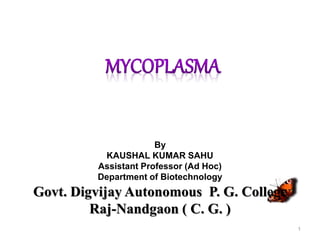
mycoplasma By KK Sahu Sir
- 1. 1 By KAUSHAL KUMAR SAHU Assistant Professor (Ad Hoc) Department of Biotechnology Govt. Digvijay Autonomous P. G. College Raj-Nandgaon ( C. G. )
- 3. Mycoplasmas are prokaryotic , without cell wall & have been placed under the class Mollicutes & the order Mycoplasmatales. Mycoplasma are the smallest microorganism which have been known to cause a number of disease in animals &human kind. The cells are bounded by a soft trilamellar lipoproteinaceous unit membrane containing sterols. Because of their plasticity , they can pass through bacterial filters & have often been mistaken for viruses. 3
- 4. 4 Kingdom : Bacteria Phylum :Firmicutes Class : Mollicutes Order : Mycoplasmatales Family : Mycoplasmataceae Genus : Mycoplasma SPECIES: M. myocides M. genitalium M. hominis M. hyopneumoniae
- 5. Louis Pasteur first noticed mycoplasmas while observing the causative agent of pleuropneumonia in culture. Mycoplasma was first reported by Nocard & Roux (1889). In the year 1930s,it became evident that mycoplasmas cannot be defined as viruses. They were first isolated from pleural fluid of cattles suffering from bovine pleuropneumonia that's why it is known as PPLO pleuropneumonia like organism. 5
- 6. Mycoplasmas are the smallest free living microorganisms,& one of the most pleomorphic; varying in shape from spherical or slightly ovoid. They are about 125-250nm in diameter during early experimental growth phases. They may be secondary branched filaments of uniform diameter ranging the length from a few to 150nm. In the late growth phases they may be in the form of chains of coccoid bodies. A dense corpuscles like structure later develop in the filament which transformed into chains of spherical bodies. 6
- 7. Mycoplasma refers to a genus of bacteria that lack a cell wall Mycoplasma have lipoprotein membrane that is three layered membrane. MYCOPLASMA 7
- 8. Since mycoplasma can pass through many filters & grow in a media which donot contain living tissues. Therefore they are considered to be microorganisms intermediate between bacteria & viruses. Chemically, they are much closer to bacteria because they possess 4% DNA & 8% RNA. 8
- 9. 9 All the species require sterols for growth. None of the species hydrolyze urea or insulin. They donot grow at 45-62c or at pH 1.0 to 3.0. The organisms grow only in isotonic or hypertonic media (with sorbitol or sucrose & requires purine & pyrimidines; as well as lipids & sterols. They lack cytochromes suggests a very limited respiratory chain. Mycoplasma are resistant to antibiotics and also sensitive to osmotic shocks. Locomotion The cells are non motile but gliding motility has been observed in few species. One end of M.pneumoniae contains a special terminal structure that apparently is responsible for locomotion.
- 10. 10 b. Resistance Mycoplasma generally resemble non-sporing bacteria in heat resistance but some strains are more sensitive, being destroyed at 45c in 15min. They are relatively resistant to lysis by osmotic shock but are very sensitive to lysis by surface active agents & lipolytic agents. They are resistant to penicillin & cephalosporin as well as to lysosomes that act in the bacterial cell walls but are sensitive to tetracyline & many other antibiotics.
- 11. 11 The actual method of reproduction in mycoplasma has not been yet proved. This adult cell may reproduce by the following two ways: 1.by binnary fission of adult cell. 2 daughter cells
- 12. 2.By forming elementary bodies. *form small elementary bodies ,when mature separate from parent cell and grow. 12 elementary bodies Large cells with developing elementary bodies intermediate cell parent cell
- 13. 13 i. The mycoplasma are characterized by their lack of cell wall,the outer boundary of the cells being the cytoplasmic membrane. ii. Therefore their cells possess plasticity & can assume various shapes ranging from spheres to branched filamants. iii. They are unicellular,invariably non-motile (except Spiroplasma), prokaryotic organisms incapable of synthesizing cell wall of cell wall materials. iv.They are susceptible to lysis by osmotic shocks caused by sudden dilution of the medium with water. v. Theycan grow and reproduce independently. vi. They produce disease in both plants and animals.
- 14. 14 Plant diseases Plant diseases assosiated with mycoplasma in the sieve tubes of the plants have one feature in common that is, upsetting the homonal balance resulting in witche’s broom growth . Some diseases are:big bud of tomato,sandal spike, strike disease of sugarcane,witche's broom of potato etc.. SYMPTOMS: leaves become small and yellow. calyx become discoloured,floral bud enlarges. usually fruit are not formed but if formed they are seedless or seeds fail to germinate.
- 15. 15 Parasitic mycoplasmas exhibit host specificity. They generally produce surface infections by adhering to the mucosa of the respiratory,gastrointestinal & genitourinary tracts. Mycoplasma cause two types of disease in humans - pneuomnia & genital infections. Mycoplasmal pneumonia disease is typically a tracheobronchitis. The onset is gradual with fever, headache & sore throat. Paroxyemal cough may occur with blood tinged suptum. Rashes, meningitis, encephalites & hemolytic anemia are other complications seen. Spread is favoured by close contact, as in families & most typically among military recruits. The mycoplasma may remain in throat for two or more months after recovery from the disease. D I S E A S E S MAMMALS:
- 16. 16 Mycoplasmas are prokaryotic,without cellwall & have been placed under the class Mollicutes & the order Mycoplasmatales. Mycoplasma was first reported by Nocard & Roux (1889). They are smallest free living organisms & one of the most pleomorphic,varying in shape from spherical or slightly ovoid. Mycoplasma have three layered lipoprotein membrane. Mycoplasmas are sensitive to supersonic vibrations,dissosiations & most of the physical environmental factors. Nucleoid present in centre of cell.Nuclear membrane and nucleolous remain absent.
- 17. 17 OTHER SOURCES- WEBLINKS BROCK 8 TH EDITION NESTER.ROBERTS.NESTER CAREER POINT
